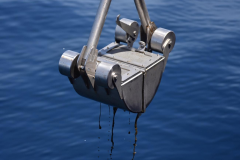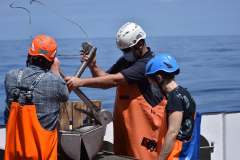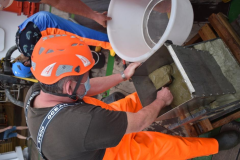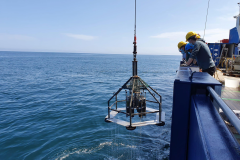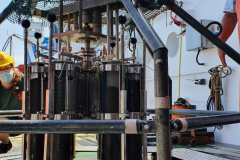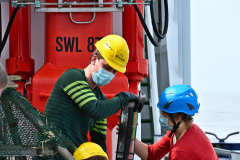
The Benguela System under climate change - Effects of Variability in physical forcing on carbon and oxygen budgets
13.01.-14.01.2022 The first sediment samples arrive on deck from the depths.
Now not only the ship but also our research programme has speeded up. One station after the other follows and everyone has a lot to do. By means of the Van-Veen grab sampler and the Multicorer (MUC) we get an insight into the beautiful fauna of the seabed. Our macrozoobenthologists on board are especially happy about this, as they can collect plenty of sample material for diversity determination.
The Van-Veen grab sampler and the Multicorer (MUC) are devices used to collect sediment from the seabed and transport it to the surface. The Van-Veen grab sampler is basically a giant dredging bucket that is lowered into the water by a rope from the ship. When the grab sampler touches the seabed, the rope between the buckets is released, causing them to close, digging out sediment. After the grab sampler and its contents are returned on board, the sediment is washed over a sieve. Larger bottom-dwelling marine organisms, technically known as marrow invertebrates, remain in the sieve and are thus available for further analysis. In the so-called MUC, on the other hand, a defined sediment surface is cut out of the seabed using Plexiglas-tubes. We then either sample these directly or use the material for further experiments.
The macrozoobenthic-group, led by Dr. Michael L. Zettler, is interested, among other things, in the distribution of different marine species living in the sediment in the Benguela upwelling area. The group is also investigating how species living in the transition zone between the mud belt (muddy sediment belt along the coast) and the sandy seabed cope with the constantly fluctuating oxygen availability on the seabed and what metabolic measures they take to bridge periods of hostile conditions such as oxygen deficiency. To this end, PhD student Katherine Amorim is conducting experiments on board with freshly collected mussels.
A look over the railing is always worthwhile. Especially in the dark, interesting spectacles await us. This evening, for example, we were able to observe pike mackerel, also called snoek, hunting the schools of fish attracted by the ship's headlights. We also spotted swarms of amphipods, which were very interesting for the macrozoobenthologists.
Text: Fabian J., Braun P. (both IOW)
| Expedition: | MSM105 |
| Mission: | BUSUC 2 |
| Start: | 11.01.2022 - Walvis Bay |
| Ziel: | 23.03.2022 - Mindelo |
